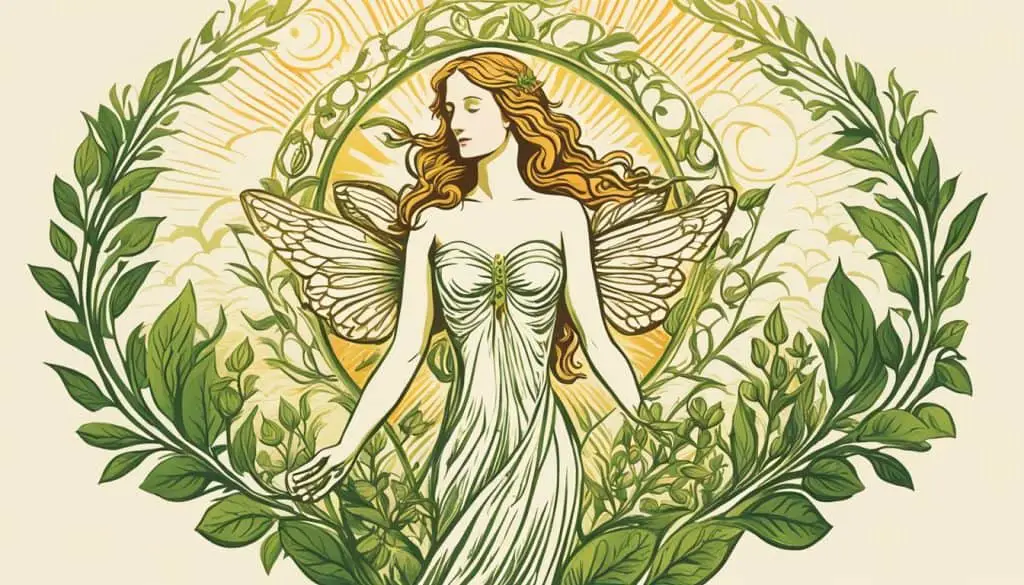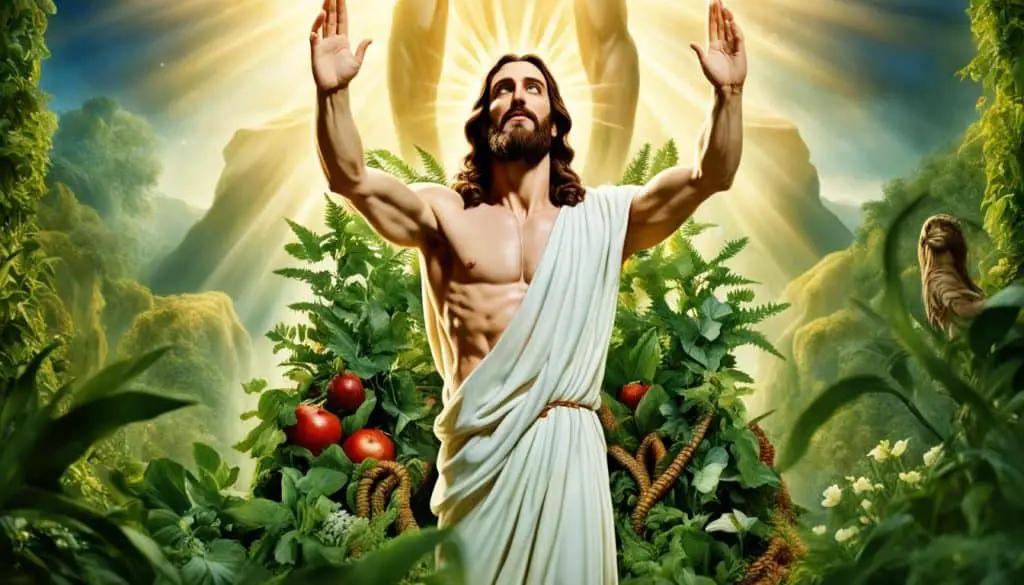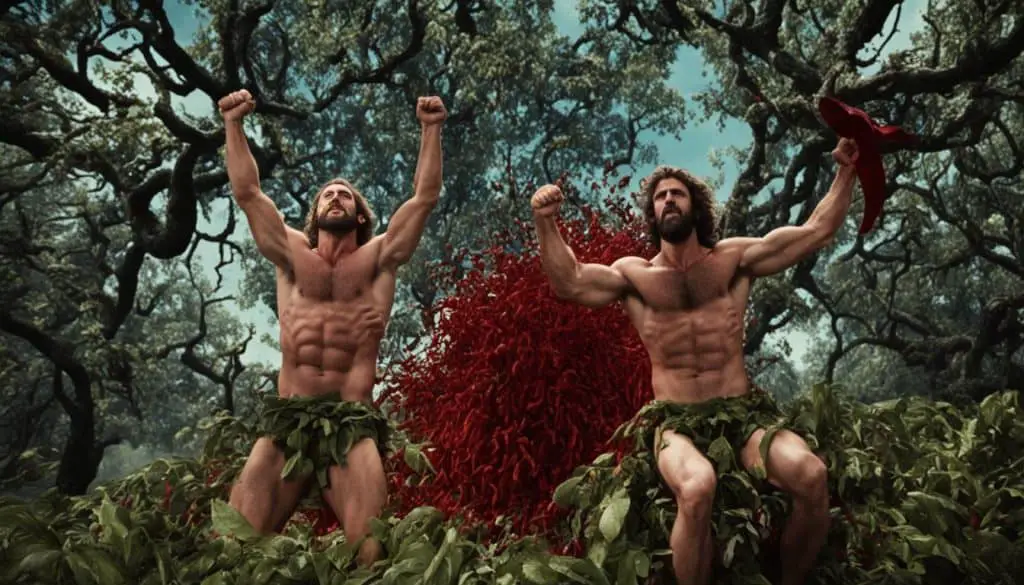Table of Contents
In this article, we will delve into the intricacies of the story of Adam and Eve and uncover the profound connections with 10 types of Christ.
These connections highlight how Adam’s role in the narrative foreshadows the coming of Christ and the subsequent redemption of humanity.
We will explore themes such as obedience, sacrifice, triumph, and the restoration of access to eternal life.
Make Sure You Watch The Video: I would love for you to subscribe to my YouTube channel as well… Thanks in advance!!
Adam as a Type of Christ
Adam, the first man created by God, is often seen as a foreshadowing of Christ, the Savior who would come to redeem humanity.
While Adam’s disobedience in the Garden of Eden led to sin and death entering the world, Christ’s obedience brought righteousness and life (Romans 5:14).
Just as Adam’s actions had far-reaching consequences, so did Christ’s obedience. While Adam’s disobedience caused a separation between humanity and God, Christ’s obedience restored the broken relationship and offered the promise of eternal life.
By exploring the parallels between Adam and Christ, we gain a deeper understanding of God’s plan for redemption.
Adam’s disobedience serves as a powerful contrast to Christ’s obedience. Adam’s choice to eat from the forbidden tree brought sin and its consequences upon all humanity.
On the other hand, Christ’s obedience to the will of God, even unto death on the cross, reconciled humanity to God and brought salvation (Philippians 2:8).
The apostle Paul highlights this contrast, referring to Adam as the “one man” through whom sin entered the world and Christ as the “one man” through whom righteousness and life abound (Romans 5:12-21).
Through Adam’s disobedience, all were made sinners, but through Christ’s obedience, the free gift of righteousness and justification is available to all who believe.
Just as Adam’s disobedience affected all of humanity, Christ’s obedience brings hope and salvation to all who trust in Him.
By examining the typological relationship between Adam and Christ, we can better grasp the significance of Christ’s redemptive work and the abundant grace He offers.
“For as in Adam all die, so in Christ all will be made alive.” – 1 Corinthians 15:22
The Contrast Between Adam and Christ
| Adam | Christ |
|---|---|
| Disobedience | Obedience |
| Brought sin and death | Brought righteousness and life |
| Separated humanity from God | Reconciled humanity with God |
| Caused a curse | Offers a blessing |
Through an examination of the contrasting actions and outcomes of Adam and Christ, we can see the significance of Christ as the fulfillment of what Adam could not accomplish.
While Adam’s disobedience brought brokenness and separation, Christ’s obedience brings restoration and reconciliation.
As we explore the typological connection between Adam and Christ, we gain a deeper appreciation for the magnitude of Christ’s redemptive work and the hope it offers to all who believe.
Eve’s Seed and Christ’s Victory
The prophecy in Genesis 3:15 reveals a significant foreshadowing of Christ’s victory over sin and Satan. This ancient verse speaks of Eve’s seed, referring to the offspring that would come from her lineage.
According to the prophecy, this seed would crush the head of the serpent, symbolizing Christ’s triumphant defeat of the powers of darkness.
This prophecy in Genesis 3:15 lays the groundwork for a messianic expectation that runs throughout the biblical narrative. It signifies the anticipation of a Savior who would conquer evil and bring redemption to humanity.
“And I will put enmity between you and the woman, and between your seed and her Seed; He shall bruise your head, and you shall bruise His heel.” – Genesis 3:15
This verse holds profound typological significance, illustrating the divine plan of salvation through Christ. Just as Eve’s offspring was destined to crush the serpent’s head, Christ’s ultimate victory over sin and Satan was predetermined from the beginning.
To further grasp the implications of this prophecy and Christ’s role in fulfilling it, we must delve into the broader themes of sacrifice, redemption, and the restoration of humanity’s relationship with God.
Eve’s Seed and the Defeat of Evil
The mention of “Eve’s seed” in Genesis 3:15 establishes a clear lineage leading to Christ, who would ultimately triumph over sin and Satan. This unique reference highlights the divine plan of salvation and foreshadows the coming of the Messiah.
Eve’s seed represents the hope of deliverance and victory over the forces of evil. It symbolizes the restoration of humanity’s relationship with God and the ultimate defeat of sin and its consequences.
Christ’s Victory Through the Cross
The fulfillment of the prophecy in Genesis 3:15 is realized through Christ’s sacrificial death on the cross. His atoning sacrifice is what makes victory over sin and Satan possible.
By willingly laying down His life, Christ conquered sin’s power and defeated Satan’s schemes. Through His resurrection, He triumphed over death itself, offering eternal life to all who believe in Him.

| Eve’s Seed | Christ’s Victory |
|---|---|
| Foretells the coming of the Messiah | Secures victory over sin and Satan |
| Signifies hope for deliverance | Restores humanity’s relationship with God |
| Points to the defeat of evil | Overcomes the power of darkness |
| Represents the restoration of life | Offers eternal life through faith in Christ |
The Tree of Life as a Symbol of Christ
In the Garden of Eden, there stood a magnificent tree known as the Tree of Life. This tree, mentioned in Genesis 2:9, symbolized not only the beauty of creation but also held a profound meaning in relation to Christ.
“And out of the ground the Lord God made to spring up every tree that is pleasant to the sight and good for food. The tree of life was in the midst of the garden…” – Genesis 2:9 (ESV)
Just as the tree of life was in the center of the garden, Christ stands central to the Christian faith as the source of eternal life. The symbolism associated with the Tree of Life in Eden reflects the eternal life offered by Christ to all who believe in Him.
Through His sacrificial death and resurrection, Christ offers the gift of eternal life, granting salvation to humanity. Just as the Tree of Life provided sustenance and vitality in the garden, Christ’s redemption offers everlasting life and spiritual nourishment.
“For the wages of sin is death, but the free gift of God is eternal life in Christ Jesus our Lord.” – Romans 6:23 (ESV)
By embracing the message of Christ and accepting Him as their savior, believers can partake in the eternal life He offers. The Tree of Life symbolizes the hope, restoration, and abundance found in the salvation offered by Christ.
| Symbolism of the Tree of Life | Significance in Relation to Christ |
|---|---|
| The tree represents eternal life and vitality. | Christ offers eternal life to those who believe in Him. |
| The tree stood in the midst of the garden, symbolizing its central importance. | Christ holds a central role in the Christian faith as the source of eternal life. |
| The tree provided sustenance and nourishment. | Christ’s redemption offers spiritual nourishment and sustenance for believers. |
| The tree represents hope, restoration, and abundance. | Christ’s salvation brings hope, restoration, and abundant life to believers. |
The First Sacrifice and Christ’s Ultimate Sacrifice
In the story of Adam and Eve, one of the significant events that foreshadows Christ’s ultimate sacrifice on the cross is the act of God clothing them in garments of skin (Genesis 3:21).
This act necessitated the first sacrifice, symbolizing the shedding of blood for the forgiveness of sins. Jesus Christ, as the Lamb of God, would later offer Himself as the ultimate sacrifice on the cross, bringing redemption and salvation to all humanity.
The clothing of Adam and Eve in garments of skin signifies the consequence of their disobedience and the necessity of atonement. Just as animals were sacrificed to cover their nakedness and shame, Christ would offer Himself as the perfect atoning sacrifice for the sin of the world.
“For God made Christ, who never sinned, to be the offering for our sin, so that we could be made right with God through Christ.” – 2 Corinthians 5:21
The sacrificial act in the story of Adam and Eve serves as a powerful foreshadowing of Christ’s ultimate sacrifice on the cross. It highlights the divine plan of redemption and the fulfillment of God’s promise to provide a way for humanity’s salvation.

The Symbolism of Sacrifice
The act of God clothing Adam and Eve in garments of skin represents the gravity of sin and the price that needed to be paid for reconciliation with God.
It symbolizes the shedding of blood as an atonement for sin and the need for a perfect sacrifice to restore humanity’s relationship with God.
Here is a table that illustrates the connection between the first sacrifice in the story of Adam and Eve and Christ’s ultimate sacrifice:
| First Sacrifice in Adam and Eve Story | Christ’s Ultimate Sacrifice on the Cross |
|---|---|
| Animals were sacrificed to cover Adam and Eve’s shame and nakedness | Jesus offered Himself as the perfect sacrifice for the sins of humanity |
| Blood was shed as a symbol of atonement | Jesus’ blood was shed for the forgiveness of sins |
| Temporary covering of sin | Permanent forgiveness and redemption |
The first sacrifice in the story of Adam and Eve pointed to the future sacrifice of Jesus on the cross, where His blood would provide the ultimate atonement for sin. It is through Christ’s sacrifice that humanity can find forgiveness, redemption, and eternal life.
The Second Adam and Life Through Righteousness
In 1 Corinthians 15:45-49, Christ is often referred to as the second Adam, embodying the redemptive role that Adam could not fulfill. While the first Adam brought death into the world through sin, the second Adam (Christ) brought life through righteousness.
This typology emphasizes Christ’s pivotal role as the restorer of life and the dispenser of righteousness.
It draws a clear contrast between the consequences of Adam’s disobedience and Christ’s obedience, showcasing how Christ’s actions offer a path to eternal life and spiritual rebirth.
In 1 Corinthians 15:45-49, the Apostle Paul writes:
“So it is written: ‘The first man Adam became a living being’; the last Adam, a life-giving spirit. The spiritual did not come first, but the natural, and after that the spiritual. The first man was of the dust of the earth; the second man is of heaven.
As was the earthly man, so are those who are of the earth; and as is the heavenly man, so also are those who are of heaven. And just as we have borne the image of the earthly man, so shall we bear the image of the heavenly man.”
This passage emphasizes the transformative power of Christ’s redemptive work, offering believers the opportunity to be conformed to His image and partake in the life-giving spirit that He embodies.
The typological connection between the second Adam and life through righteousness showcases the profound impact of Christ’s sacrifice and resurrection.
By embracing His teachings and following His example, believers can experience a spiritual rebirth and find eternal life through the righteousness imparted by Christ.

Contrasting the First Adam and the Second Adam
| The First Adam | The Second Adam (Christ) |
|---|---|
| Brought death through sin | Brings life through righteousness |
| Failed to fulfill his role as a righteous leader | Fulfills the role as the perfect and righteous Savior |
| Lost access to the tree of life | Restores access to eternal life through faith |
| Highlighted humanity’s fallen nature | Redeems humanity and offers spiritual rebirth |
As depicted in the table above, the typological contrast between the first Adam and the second Adam underscores the transformative power of Christ’s redemptive work. Through His life, death, and resurrection, Christ offers forgiveness, righteousness, and the promise of eternal life to all who trust in Him.
The Groom and the Bridegroom
In the biblical narrative, Adam’s role as the first groom sets the stage for the profound parallel between his relationship with Eve and Christ as the bridegroom of the church. This symbolic connection highlights themes of love, sacrifice, and unity.
Adam’s role as the first groom foreshadows Christ’s role as the ultimate bridegroom. Just as Adam loved and cherished Eve, Christ loves and cherishes the church. This is beautifully expressed in Ephesians 5:25-32:
“Husbands, love your wives, just as Christ loved the church and gave himself up for her to make her holy, cleansing her by the washing with water through the word, and to present her to himself as a radiant church, without stain or wrinkle or any other blemish, but holy and blameless.
In this same way, husbands ought to love their wives as their own bodies. He who loves his wife loves himself. After all, no one ever hated their own body, but they feed and care for their body, just as Christ does the church— for we are members of his body.
‘For this reason a man will leave his father and mother and be united to his wife, and the two will become one flesh.’ This is a profound mystery—but I am talking about Christ and the church.”
This scripture emphasizes the sacrificial love and selfless devotion that both Adam and Christ exemplify in their relationships.
Adam’s love for Eve demonstrated his willingness to leave his family and be united with her. Similarly, Christ’s love for the church led Him to sacrifice Himself on the cross to make her holy and blameless.
The parallel between Adam and Christ as husband figures underscores the significance of their relationships. Adam’s relationship with Eve was the foundation of human marriage, and it served as a foreshadowing of the divine union between Christ and the church.

“As the bridegroom rejoices over the bride, so shall your God rejoice over you.” – Isaiah 62:5
| Adam | Christ | |
|---|---|---|
| Role | First groom | The ultimate bridegroom |
| Love | Love for Eve demonstrated his willingness to leave his family and be united with her | Sacrificed Himself on the cross to make the church holy and blameless |
| Significance | Foundation of human marriage | Divine union between Christ and the church |
This table highlights the key attributes and significance of Adam and Christ as groom figures. While Adam played a foundational role in human marriage, Christ’s love and sacrifice for the church exemplify the divine union between Himself and His followers.
Suffering and Triumph in Adam and Eve Story
In the narrative of Adam and Eve, we witness the profound connection between suffering and triumph. Their disobedience in the Garden of Eden resulted in suffering and the entrance of sin and death into the world.
However, this suffering set the stage for Christ’s ultimate triumph and the redemption of humanity.
Just as sin entered through Adam and Eve’s transgression, so did the resurrection of the dead come through one man, Christ Jesus (1 Corinthians 15:21).
Christ’s suffering on the cross and His subsequent resurrection brought about the triumph over sin and death, offering salvation and eternal life to all who believe in Him.
In Adam and Eve’s story, we see a foreshadowing of Christ’s suffering and resurrection. Their experience serves as a reminder of the consequences of sin, while also pointing towards the hope and victory found in Christ.
Through His sacrifice and triumph, Christ brings restoration, forgiveness, and the promise of eternal life.
Table: Symbolic Comparison of Suffering and Triumph in Adam and Eve and Christ’s Narrative
| Adam and Eve | Christ |
|---|---|
| Their disobedience leads to suffering and consequences. | Christ’s obedience leads to triumph over sin and death. |
| Sin enters the world through their fall. | Through His resurrection, Christ brings life and salvation. |
| They are banished from the Garden of Eden. | Christ opens the way to eternal life and restores humanity’s relationship with God. |
Through the suffering in Adam and Eve’s story, we gain a glimpse of the immense love and sacrifice shown by Christ. His suffering on the cross brings about the ultimate triumph and offers a path to redemption for all who believe.
As we reflect on the suffering and triumph in Adam and Eve’s narrative, we are reminded of the transformative power of Christ’s suffering and resurrection in bringing about our salvation.

What Are the Different Ways the Adam and Eve Story Can Offer Lessons for Christians?
The Adam and Eve story can offer valuable lessons for Christian perspective. It teaches about the consequences of disobedience, the importance of faith, and the possibility of redemption through forgiveness. Christians can also learn about the enduring power of God’s love and the need for humility and repentance.
The New Creation and Access to the Tree of Life
As we explore the profound connections between the story of Adam and Eve and the typology of Christ, we come to understand that just as Adam was the head of the old creation, Christ is the head of the new creation.
Believers in Christ are transformed into a new creation, a spiritual rebirth that parallels the way life originally began with Adam.
In the book of Revelation, we find a powerful symbol of this spiritual rebirth and restoration of humanity’s access to eternal life – the tree of life.
This tree, once forbidden to Adam and Eve, is now made accessible to those who embrace the redemptive work of Christ. Revelation 22:14 reveals that through Christ, believers have the blessed privilege of partaking in the eternal life symbolized by the tree of life.
This typological fulfillment serves as a stark contrast to the consequences of Adam and Eve’s sin in the Garden of Eden. Their disobedience led to their banishment from the tree of life, cutting off access to eternal life.
However, in Christ, the lost access is restored, and believers are granted the opportunity to experience everlasting life through Him.
By embracing the role of Adam as the head of the old creation and recognizing Christ as the head of the new creation, we understand the transformative power and eternal significance of accepting Christ into our lives.
Through Him, we are made new, our access to the tree of life is restored, and we can experience the abundance of eternal life that Adam and Eve once forfeited.






